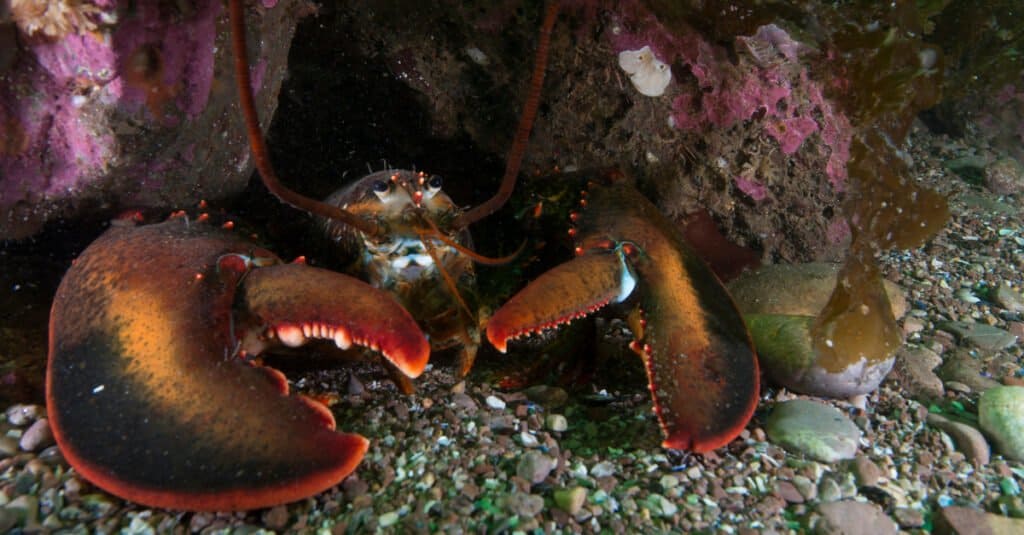If you think you’ve had a long day, consider the story of Louie, a 132-year-old lobster that lived in a clam bar for twenty years before his miraculous escape! This incredible creature was released into the open ocean by his friends at the seafood restaurant, and it’s an inspiring tale that reminds us of our responsibility to protect the planet. Let’s dive in and learn more about this amazing lobster’s extraordinary journey.
Click The Link To Hear The Heartwarming Tale:
Louie The Lobster
Louie’s life began over 130 years ago when he was born in the Atlantic Ocean. To put that into perspective, he would have been born around 1885 — when Grover Cleveland was President! That means he may have seen two world wars, three different centuries, and multiple technological revolutions since then! What an incredible life this lobster must have lived so far.

Lobsters have a very long lifespan and are capable of complex problem-solving.
©Haland/Shutterstock.com
Louie spent much of his life living among other lobsters until he was caught off Long Island by fishermen and sold to a seafood restaurant in New York City. For 20 years, Louie lived inside a glass tank in a New York seafood restaurant called “Peter’s Clam Bar”, where he became part of the family for many staff members and customers alike.
Freedom for Louie The Lobster

Some types of lobsters are green to blend in near rocks.
©OSDG/Shutterstock.com
When Butch Yamali bought the clam bar, he also became quite fond of Louie, who had already been living in the restaurant for over 15 years at the time. Louie was a large lobster, weighing in at 22 pounds, so not many people tried to tackle the task of cooking him (he couldn’t fit inside most cooking pots!). However, one day a customer offered Butch $1,000 for Louie but instead of taking the money, Butch decided it was finally time for him to be free again. After all these years, he knew it was only fair that Louie should live out his remaining days as nature intended — not cooped up in a tank in some restaurant.
So, in June 2017 — National Lobster Month — they loaded up a boat off Long Beach Island and gave Louie one last ride before setting him free into the Atlantic Ocean. While most Americans celebrate National Lobster Month by eating lobster, Peter’s Clam Bar celebrated by releasing one of its largest lobsters back into the wild. The Town Supervisor of Hempstead, Anthony J. Santino, attended the ceremony and pardoned Louie during his speech.
The fate of our beloved friend and accidental celebrity remains unknown; however, we can only hope that he is living out his days peacefully out on open waters after such an incredible journey! We may never know what happened to him, but his story serves as an inspiration for us all to make decisions based on kindness rather than monetary gain and that sometimes even animals deserve second chances at life!
How Long Do Lobsters Normally Live?

For the American lobster, the molting process can result in death.
©RLS Photo/Shutterstock.com
Lobsters have a long life expectancy and are known to live up to 50 years or more. Factors that influence their lifespan include the size, the water temperature, the presence of predators, and the quality of their habitat.
Larger lobsters tend to have longer lifespans than smaller lobsters since they are able to better defend themselves against predators. Colder water temperatures also tend to prolong their lifespan because the metabolism of the lobster slows down in colder temperatures.
The presence of predators is another key factor that influences the lifespan of lobsters. Lobsters are preyed upon by octopuses, crabs, sea stars, and eels. Without adequate protection from predators, the life expectancy of a lobster can be significantly reduced.
Lastly, the quality of the lobster’s habitat is a major factor that affects its lifespan. A clean, well-oxygenated habitat with plenty of food and shelter will help a lobster live a longer life. Poor water quality, lack of food, and limited hiding places can significantly reduce a lobster’s life expectancy.
How Big Do Lobsters Get?

Some species of lobster can be quite large!
©davemhuntphotography/Shutterstock.com
Lobsters come in a variety of sizes. The smallest species of lobster, the European Lobster, typically grows to a maximum size of about 7-9 inches long and weighs between 1-2 pounds. The American lobster is much larger, growing to a maximum size of over 20 inches long and weighing up to 25 pounds. The giant lobster, found in Australia, can reach a maximum size of up to 4 feet long and weigh up to 50 pounds.
The size of a lobster can vary significantly depending on its species and age. Lobsters can live for many decades, and they continue to grow throughout their lives. Some lobsters even outgrow the size of their shells and must shed them in order to continue to grow. Lobsters that have been able to shed their shells multiple times can reach impressive sizes.
Lobsters are also capable of regenerating lost limbs, and some lobsters with multiple regenerations can become even larger than average. There have been reports of lobsters reaching sizes of up to 6 feet and weighing up to 80 pounds.
No matter the size, lobsters are an impressive species of marine life. Their size, along with their ability to regenerate and shed their shells, makes them an interesting creature to study.
The photo featured at the top of this post is © Roman023_photography/Shutterstock.com
Thank you for reading! Have some feedback for us? Contact the AZ Animals editorial team.






